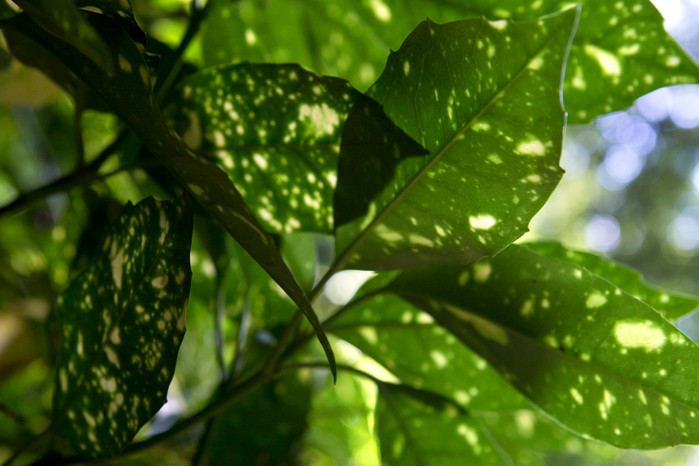
Aucuba japonica, which is commonly known as spotted laurel and sometimes also called Japanese laurel, is an evergreen shrub which is tough, hardy and easy to grow. Aucuba is a useful and hard-working shrub that creates structure and interest all year round. Most notable is that aucuba is one of the few shrubs that thrives in shade and is reasonably fast-growing for an evergreen shrub (which are generally slower growing, compared to deciduous shrubs).
The principal attraction of aucuba is its large glossy leaves which can be up to 20cm long and a range of varieties offer differing leaf colours ranging from dark green, variegated with white or yellow, or splashed with bright yellow. Named varieties are nearly all either male or female: bright red berries up to 1cm across are produced by female varieties if a male variety is growing nearby, these berries appearing in autumn and usually remaining on the plant all winter. There are some varieties that bear male and female flowers on the same plant. Aucuba thrives on almost all soils and is often seen growing in cities as it is tolerant of polluted air.
All parts of aucuba are slightly toxic and can cause mild stomach upset if ingested. Wear gloves as a precaution when handling the plant and wash hands well afterwards. Ensure small children do not pick and eat the bright red berries.
How to grow Aucuba japonica
Buy and plant aucuba at any time of year when weather conditions permit; autumn or early spring are the optimum times. Plant in sun, partial shade, or full shade, depending on the variety, and keep moist during dry spells for the first growing season. Prune if necessary to restrict growth, in spring.
Aucuba japonica: jump links
Where to grow aucuba
Aucuba japonica ‘Marmorata’
Site aucuba in a mixed border or a woodland garden. Aucuba also makes a good an informal hedge where there is at least 1.5m of width for the hedge to grow, as aucuba won’t tolerate regular trimming. Spacing depends on the ultimate width of the variety. Grow the most compact varieties in large pots or at the edges of borders. Plant in sun, partial shade or full shade depending on the variety: variegated types can develop leaf scorch if sited in full sun and produce the best leaf colours in partial shade.
How to plant aucuba

Aucuba japonica
Aucuba grows in a wide range of soils and conditions, is tolerant of poor soils and pollution, but doesn’t thrive on waterlogged ground. The ideal soil would be fertile and moisture-retentive yet well-drained. Plant ideally in spring or autumn. Dig a hole larger than the roots, remove the pot and unwind any congested roots, spreading them out in the planting hole. Plant so the top of the root ball is at ground level, backfill with excavated soil and firm in using the heel of your boot. Water well to settle the soil around the roots and keep moist during dry spells for the first growing season. To grow aucuba in pots, use a soil-based potting compost.
Where to buy Aucuba japonica online
Caring for aucuba
Plants growing in the ground need little care once established. Mulching the soil annually with composted bark or garden compost helps improve the soil’s nutrition and water-holding capacity, and plants benefit from an application of general fertilizer every spring.
How to prune aucuba
Aucuba doesn’t need any regular pruning. If plants need to be cut back to restrict growth, do so as required in spring or summer.
How to propagate aucuba
Sow seed of female varieties in pots and stand in a sheltered spot outside to germinate and grow on. Or look for self-sown seedlings near the parent plant and pot up or transplant these whilst small.
Take semi-ripe cuttings in summer, selecting healthy shoots of the current year’s growth that has just started to become woody.
Growing aucuba: problem solving
Once established, aucubas are trouble free providing they are not growing in an unsuitable site.
Brown or black patches
Bright sunlight can cause brown or black scorched patches on the leaves of variegated varieties: avoid growing such varieties in sites that get sun in the hottest part of the day and plant in partial shade.
Wilting leaves
Waterlogged soil is liable to cause rotting and plants may die.
Self seeding
Self seeding can be a problem with female varieties. Prevent seeding by picking off the berries at the end of winter.
Aucuba is not subject to any pests or diseases.
Advice on buying aucuba
- You can find Aucbua japonica in most garden centres but for the widest selection, buy online
- There’s often a choice of plant and pot sizes with larger, more costly plants available to create instant impact. In autumn and winter, aucubas are available as rootballed plants (which have been lifted from the ground when dormant) rather than container-grown – these often give better value for money in terms of plant size
Where to buy Aucuba japonica online
Varieties of Aucuba japonica to grow
Aucuba japonica ‘Picturata’ – bold, gold blotches on the leaves and male flowers.
Height x Spread: 2.5m x 2.5m
Aucuba japonica ‘Crotonifolia’ – this popular variety has yellow-flecked leaves and bright red berries in autumn.
H x S: 3m x 3m
Aucuba japonica ‘Rozannie’ (or ‘Roxannie’)– a compact variety with glossy green leaves and both male and female flowers, followed by bright red berries in autumn.
H x S: 1.5m x 1.5m
